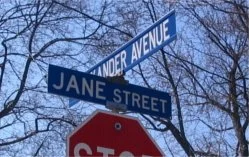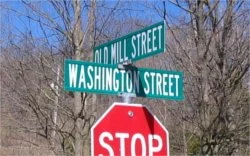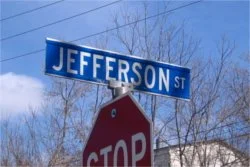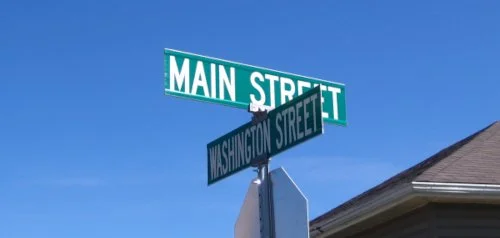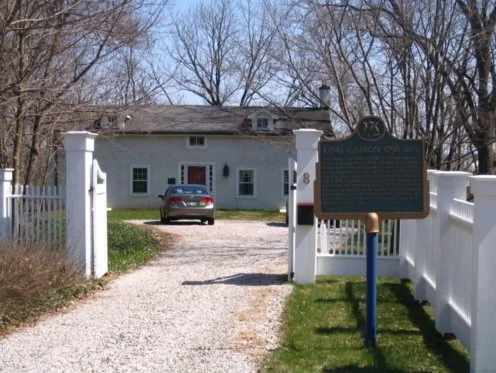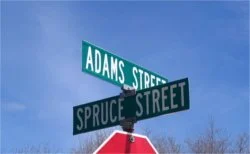The Capron family
In 1831 Hiram "King" Capron, the founder of Paris, built a new house at the eastern end of what was to become known as Homestead Road. By this time Capron had purchased and cleared the land from what is now Banfield Street north to Silver Street and from the Grand River west to beyond the Junction. The homestead -- minus some of its original outbuildings -- still stands today and is thought to be one of the oldest buildings in Paris.
In the years since, as Paris has undergone multiple bursts of development, streets in the area of Capron's homestead and beyond have been named after Capron and various members of his family.
Reference:
At the Forks of the Grand: 20 Historical Essays on Paris, Ontario
by Donald A. Smith
The intersection of Homestead Road and Hiram Road is less than 100 metres from Hiram Capron's homestead.
Banfield was the name of one of Hiram Capron's sons. It was also the name of Hiram Capron's great, great grandfather.
Hiram Capron's daughter Jane Capron, "the last living link between the village and the town", died in 1934 at the age of 95. William Street, Charlotte Street, Helen Street and Emily Street were also named in honour of Hiram Capron's children.
Horace Capron was the name of Hiram Capron's brother.
Famous Americans
Those who have grown up in typical Ontario towns are used to seeing a set of common street names: King Street, Queen Street, James Street, John Street, Mary Street and Ontario Street. Some of those streets do exist in Paris, but there are others that follow a different pattern.
Many of the early builders of Paris were Americans. Hiram Capron was born in Vermont. Levi Boughton, Norman Hamilton and Asa Wolverton were born in New York State. These men came to Paris decades before Confederation in Canada and while The United States was still a young country. It is not surprising then, that many old Paris street names sound like they could be from an American town.
Hiram Capron, in particular, was said to have been a great admirer of Thomas Jefferson.
Reference:
At the Forks of the Grand: 20 Historical Essays on Paris, Ontario
by Donald A. Smith
George Washington (1789–1797) was the first US president and a hero of the American War of Independence. Washington Street is in Paris' south end and runs north/south from King Edward Street to Old Mill Street/Mile Hill Road.
John Adams (1797–1801) was the second US president. Adams Street is in Paris' Junction neighbourhood and runs north/south from Silver Street to Spruce Street.
Thomas Jefferson (1801–1809) was the third US president. Jefferson Street is in Paris' Junction neighbourhood and runs north/south from Silver Street to Spruce Street.
Benjamin Franklin was one of the most important and influential Founding Fathers of the United States of America. Franklin Street is also in Paris' Junction neighbourhood and runs north/south from Silver Street to Spruce Street.
Why Main Street isn’t the main street
In 1830, when founder Hiram Capron hired Lewis Burwell to survey what was to become the town of Paris, Capron envisioned a “lower town” and an “upper town”.
In the lower town Broadway was to be the main business thoroughfare flanked by West River Street and East River Street. East River Street would later become River Street and finally Grand River Street North. Early in the history of Paris, the lower town was the home of mills powered by the Nith and Grand rivers. It was also home to the mill workers. The mill owners lived up the hill to the north on what became known as Snob or Quality Hill.
The upper town centred on the east-west traffic on Dundas Street, the road built by Lieutenant Governor of Upper Canada John Graves Simcoe. The road connected York with London. The section between Dundas and Paris is still known as Governor’s Road. The upper town was home to the first churches and schools in the town; the old Village Hall and later the Town Hall (now The Bawcutt Centre); as well as livery stables, taverns and hotels patronized by those travelling by horse and stage coach along Dundas Street. Main Street is one block south of Dundas Street in an area developed by Robert Roseburgh.
As travel by train became the norm and the importance of the mills and businesses in the lower town grew, the importance of the upper town faded. Grand River Street North eventually became the centre of commercial activity in the town. The area surrounding Main Street is now largely a residential neighbourhood.
Reference:
At the Forks of the Grand: 20 Historical Essays on Paris, Ontario
by Donald A. Smith


